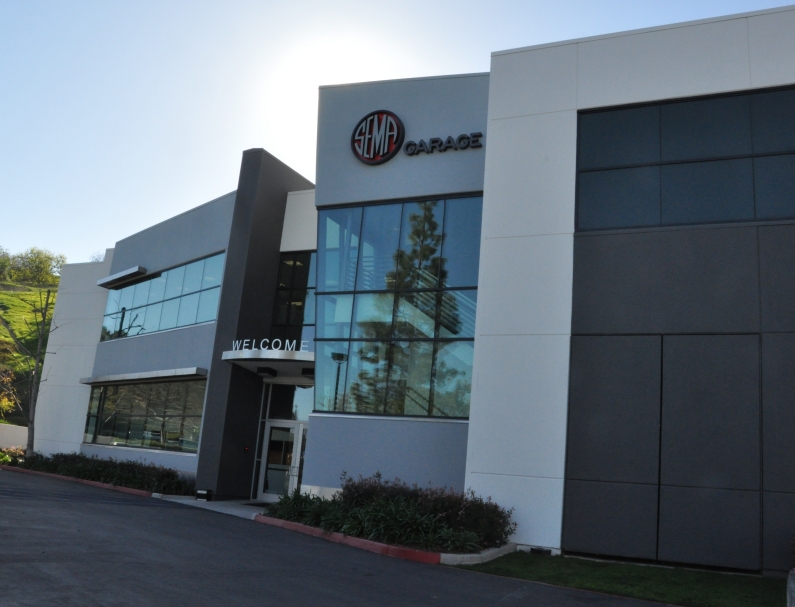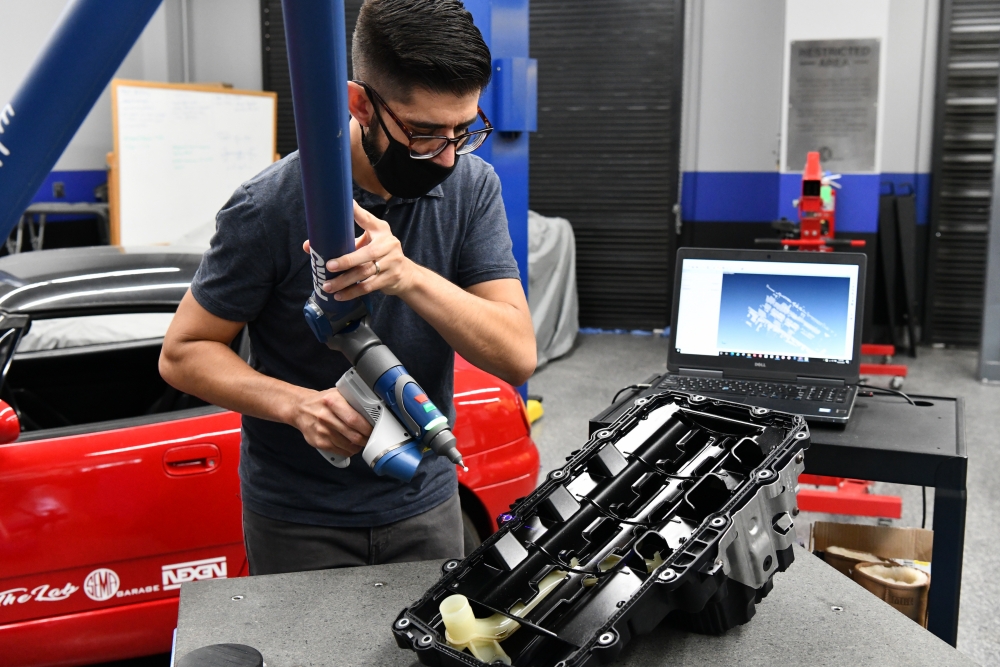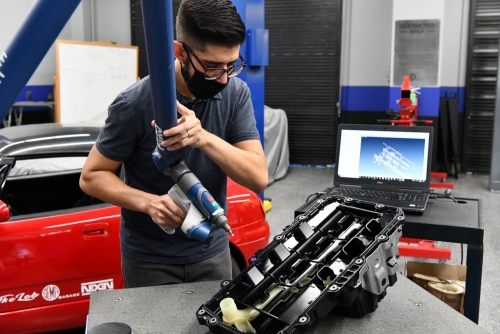BUSINESS TECHNOLOGY
By Douglas McColloch
SEMA Garage Gets Updated Scanning Capability

companies bring their products to market more quickly and cost-
effectively. The Garage plans to expand the reach of its Tech Transfer
program in 2021.
Each year, SEMA members introduce thousands of cutting-edge tools and accessories designed to add enjoyment to vehicle ownership. While some have universal fitments, many have model-specific applications that require significantly more research and development (R&D).
The SEMA Garage provides SEMA-member companies with access to the latest technology, tools and services, as well as a team of engineers to help product developers bring their innovations to market quickly and efficiently.
The 15,000-sq.-ft. facility offers a variety of services, including a two-bay garage equipped with vehicle lifts and tools for product test fitment, R&D and installation; an emissions lab dedicated to all aspects of emissions compliance, including preparation of California Air Resources Board (CARB) Executive Order (EO) applications, lab testing and interactions with CARB/U.S. Environmental Protection Agency on behalf of SEMA members; a staff of engineers dedicated to the management and distribution of OEM CAD data directly to aftermarket parts manufacturers; two Stratasys 3-D printers capable of outputting more than 10 different types of plastic-based rapid prototypes in various applications; two 3-D scanners—a FARO ScanArm and a handheld ARTEC Leo—that are capable of digitizing physical products for CAD design; and a training center with the capacity for hosting 100 people for new product reveals and other functions.
While SEMA already offers a variety of R&D and technical-support initiatives through SEMA Garage, the organization is always looking for ways to improve its services to stay abreast of the rapid changes in automotive technologies and to better respond to the evolving needs of its member companies. We recently spoke with Luis Morales, SEMA Garage mechanical engineer, to review some of the upgrades and to explain how member companies can best utilize them to their advantage. What follows has been edited for clarity and length.
SN: Tell us about some of the new developments that have taken place this year in the SEMA Garage and about some of the technological upgrades.

scan a much wider area than the Garage’s previous FARO arm and
can save members time and money.
LM: I’d like to focus on the 3-D scanning technologies that we’ve brought onboard. First, we’ve improved our 3-D scanning service by bringing in new technology. Before, we used to operate only a FARO edge scan arm. It’s a stationary system, so it’s on a tripod—meaning that it can only reach as far as the arm’s length, which was 9 ft. at the time. Then you would have to move the arm around the vehicle to capture the entire vehicle, for example.
Now we have upgraded that arm to what is known as the FARO Quantum M FaroArm v2, and this model has an 11.5-ft. measurement range, so we have increased the range that we can extend the arm itself, and it still holds an accuracy of three thousandths of an inch. This is what we use to help our members either reverse-engineer a product that they have developed in the past and they have no digital reference to, or we can use this arm to reverse-engineer mounting areas on an existing vehicle for somebody to develop a product. We can also use it to digitize the entire exterior of a vehicle, and we do that for many members who are making body kits, roof racks, interiors and such. So for starters, we have upgraded our FARO-branded equipment.
In addition to that, we have expanded our capabilities by introducing a new system known as the ARTEC Leo from ARTEC 3D Systems. It’s a handheld unit, and it’s basically a scanner with a camera in front of it. With that unit, you can walk around an entire vehicle and not have to worry about mounting it anywhere.
SN: Why not just use the ARTEC instead of the FARO arm? It sounds simpler and more convenient.
LM: As with anything else, there’s a give and take. In this case, the FARO has an accuracy of three thousandths of an inch, which is great. The ARTEC Leo, being capable of capturing larger objects at a much faster rate, has an accuracy of eight thousandths of an inch. However, with the ARTEC Leo, you can capture a scanning frame of 21/2 x 11/2 ft. in a single pass. That’s huge compared to what the FARO can do, but again, you sacrifice size versus accuracy. Nonetheless, we always work with our members to find out what their needs are, and if higher accuracy is something that they’re looking for, we’ll use the FARO arm. If size is a priority over accuracy, we’ll use the ARTEC.
Also, with the ARTEC Leo we can travel to different member facilities across the country when possible and help them out. It fits into a small briefcase that you can carry on an airplane, so it’s very portable. The FARO, by contrast, is a more stationary system that we keep in-house.
We’ve been working very well with both of the systems in the past couple of months. We’ve actually used them in conjunction with each other in cases where we capture some data with the FARO arm to be accurate and then also capture the overall image of the vehicle or the product itself with the ARTEC. We can actually combine them, so they complement each other.
SN: Besides offering a greater diversity in scanning services, what other benefits do these new models confer for member companies?
LM: The extra length of the new FARO arm means that we can complete a job at a much faster rate. We capture data more quickly than we could in the past because of the arm’s reach. That saves us time and saves the members time and money.
When looking at the handheld unit, we now have the capability to help our members by capturing data that was limited or wasn’t possible to capture with the FARO arm itself. As an example, think about a member who is designing something that goes inside of a truck bed or on the roof of a vehicle. Those two places were very difficult to capture with the FARO arm—even impossible in some cases. Now that we’ve overcome that issue with the ARTEC Leo system, because it is handheld, we can take the unit with us to the top of a ladder and freely scan the roof or the inside of a bed. That’s going to help us with data for truck beds, roofs, interiors, seats—you name it. Anything that was physically limited by the FARO arm is now overcome because we have the ARTEC to complement it.
SN: For those members who might still hesitate about visiting the Garage during the COVID-19 disruption, could you elaborate on some of the safety and sanitation protocols SEMA Garage
has adopted?
LM: The majority of our services that we operate in the product-development side of the SEMA Garage are contactless, including
the Tech Transfer program, 3-D printing and such. A member can simply reach out to us via email and we’ll exchange data that way, or we’ll exchange files that way.
In a case where we have to physically scan a product in the Garage, we cannot allow members to stay in the facility due to the safety and authentication protocols we have adopted. We invite them to schedule an appointment to drop off a vehicle, and we bring it into the facility. We wipe it down and clean it, and we clean the keys. We sanitize the vehicle anywhere we come into contact with it. We do our job of scanning the requested areas, we sanitize the vehicle again, and we have the member pick it up.
We have safety guidelines in place within our facility where everybody has to wear a mask at all times. We social distance while at our workspaces, and we have PPE at the entrance and hand sanitizer in every room of the facility. But at this time, we unfortunately cannot have members in the facility itself.
SN: Looking forward to 2021, are there any other initiatives or upgrades in the works that you care to share with
the members?
LM: We’re always growing the Tech Transfer 3-D scan library, but with the upgraded scanning systems, we now see an opportunity to grow it significantly—much faster, much more data and more vehicles to scan.
Right now in the Garage, we have the ’20 Polaris RZR Pro and ’20 Can-Am Maverick X3 for the side-by-side market. We have classic vehicles too. We now have a ’69 Ford Mustang and ’68 Ford Bronco. We’re capturing data on those vehicles using both scanners, which means more data, more value to members and more value to the program.
We’re going to be adding another focus into our scanning services toward the import side of things. In the past, we’ve had partnerships with Ford, General Motors, Cummins and Fiat Chrysler Automotive through the Tech Transfer program. They’ve helped us out by providing us with OE CAD data. Then we started capturing our own data using scanners for vehicles that were outside of that group, which included off-road vehicles, Toyotas and Nissans. Now we see this opportunity to go deeper into the tuner side by capturing data for imported Japanese vehicles.
We are currently working on scanning a ’92 JDM Suzuki Cappucino. Now, that’s not something that you would commonly see around here, but if you are interested in developing a product for that vehicle, you can utilize our data as a reference for your development and put your product out into the market. We plan to start with that vehicle but also to use our connections to get our hands on more Japanese imported vehicles and therefore expand the interest of tuner enthusiasts and import enthusiasts into our market.
We currently have 562 scan files that are composed of 26 vehicle makes and 99 models. Within the next year, we plan to grow those numbers significantly.
For more information about accessing the SEMA Garage’s full range of services, visit www.semagarage.com.
SEMA Garage: Member Services
The SEMA Garage provides member companies with a variety of services and equipment to improve efficiencies in product development, accelerate product time-to-market, and streamline R&D procedures and protocols. Among the services offered are:
Tech Transfer: SEMA members can access CAD OEM data to develop high-quality parts quickly and cost-effectively. Participating OEMs include Ford, Lincoln, General Motors/Chevrolet, Chrysler, Dodge, Ram, Jeep, Fiat and Scion. As mentioned in this article, SEMA is also creating a scan library of other vehicles and products using Faro/CMM and ARTEC Leo.
Measuring Sessions: The SEMA Garage offers on- and off-site domestic and international vehicle measuring sessions. The Garage has specialty tools available, including spring-measuring equipment, corner-weight scales and a CMM operated by SEMA staff. Private domestic vehicle measuring sessions are available on an exclusive basis. Upon request, non-U.S. vehicles can be delivered to a member’s place of business for private measuring sessions and R&D purposes.
3-D Printing: The SEMA Garage offers this service using a state-of-the-art Stratasys 450MC and F370 3-D printers. This service allows members to print physical models of their products that they can see, touch and test, eliminating costly redesigns before starting production. Staff engineers can work with 3-D digital part files to control the look, strength and precision of the part as well as the time, expense and overall efficiency of the print process.
Emissions Compliance: The SEMA Garage includes an automotive emissions laboratory where SEMA manufacturer members are able to test their products at an affordable cost, and the Garage’s Compliance Center includes experts and resources available to help members navigate the process, including evaluation of member products and recommendations for compliance procedures; assistance with the CARB EO process; interaction with CARB staff on behalf of member companies; and review and evaluation of test data.
Training Center: The SEMA Garage includes a fully equipped training facility that companies can use for a variety of functions, ranging from new-product reveals to company educational seminars. Catering can be provided upon request, and use of the facility is free to SEMA members.






